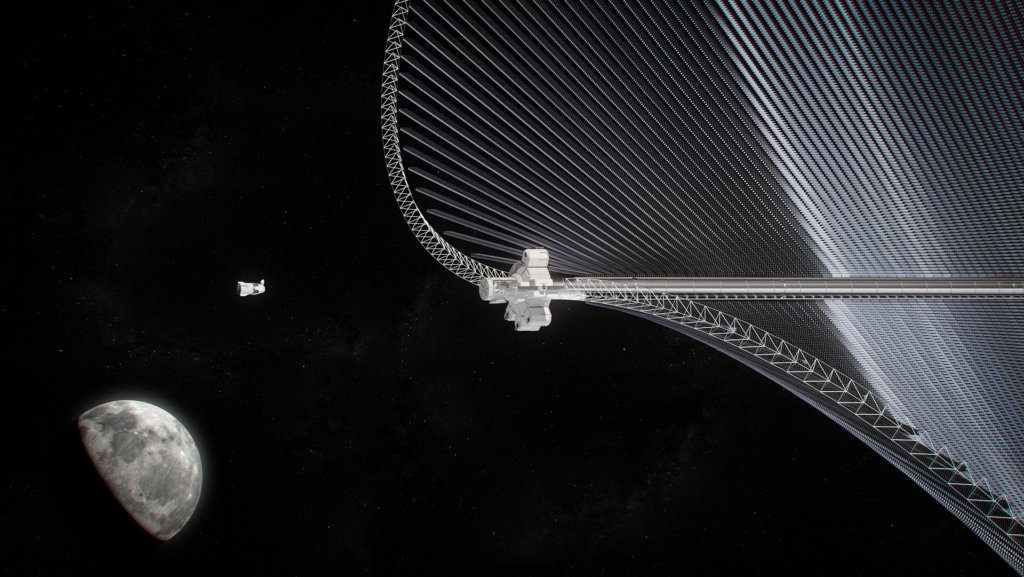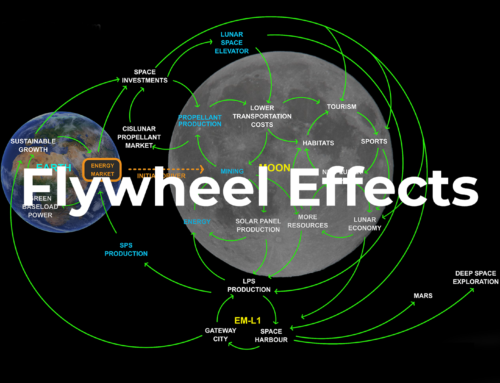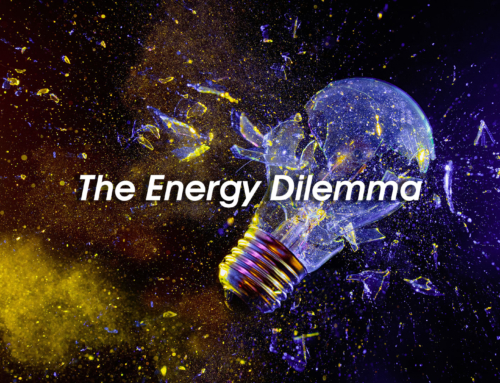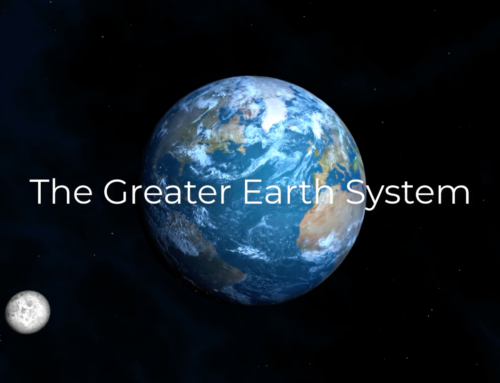As the 21st century unfolds, humanity finds that it needs more room and more resources to sustain its numbers and to maintain its thirst for further development and knowledge. The finite planetary resources that contributed immensely to its present state are being exhausted to unsustainable levels and their uncontrolled use within the biosphere is resulting in severe ecological damage as climatic and environmental changes pose a threat to future of all life. Programs to address these issues with terrestrial solutions will lead to severe societal and geopolitical consequences. There are many challenges currently facing humanity. A few of the most urgent including: the Climate Emergency, the Energy Dilemma, the Economic Crisis, Water Scarcity and Geopolitical Conflict can be addressed via the Space Energy Option.
Most people intuitively assume and fundamentally believe that terrestrial problems must have terrestrial solutions. This is likely due to a lack of understanding about our interconnectedness and interdependence with the rest of the cosmos. As a terrestrially evolved organism, it is in our genes to adapt to our immediate environment as we have over millions of years. Only recently has humanity begun to become more precisely aware of how celestial events have been critically important to the appearance and evolution of life on Earth. Impacts of comets and asteroids most likely provided a young Earth with the necessary water and perhaps even the necessary genetic materials for life to appear. Subsequent impacts are believed to have resulted in mass extinctions of life at various times in the history of our planet. The cycles of the Sun have resulted in a number of cold periods or ice-ages where life had to struggle to survive and numerous warm periods where life has flourished and spread.
The Sun’s energy that reaches the Earth’s surface warms the planet, drives the hydrologic cycle and is the primary source of energy for the climate system which keeps Earth suitable for life. Solar activity which modulates the influx of galactic cosmic rays (high-speed particles that strike the Earth from space), has been shown to have a direct influence on cloud formation and has been correlated with warmer periods during high solar activity and cooling periods during low levels of solar activity. The Moon’s gravitational influence on the Earth produces the ocean tides which impacts the ecosystems, influences the dynamics of plate tectonics which creates a unique continent/ocean duality on our planet and provides spin/axis and rotation stabilization without which life may not have appeared and evolved and life on the surface of Earth would be impossible.
The human species has evolved from this cosmic background, and it is in its genes to find cosmic solutions to ensure its own survival as well as the of survival all life sharing the home planet. As the most highly evolved species on Earth, one with awareness of its environment, it has the unique ability to make conscious choices about its future. And now, in recent times, human civilization has become increasingly dependent on technological assets located in space. As such, humanity’s future on Earth is irrevocably linked to its future in space and consequently, the Space Option represents the ‘cosmic choice’ it must soon make.
The Space Option
The Space Option concept was first introduced in 1993 at the 44th International Astronautical Congress in Graz, Austria [1]. It is an evolutionary plan to meet the basic and anticipated needs of humanity with the addition of utilizing near Earth resources - not only for the in-situ support of science or exploration – but in addition to apply these resources and/or their products for use on Earth at a conspicuous level. Most immediately, the harnessing of inexhaustible amounts of clean energy from space would replace humanity’s dependence on the continued use of fossil fuels while insuring humanity’s future energy needs. This would also provide the basic means for restoring the environment, sustaining the world economy, reducing poverty, and stimulating progress in the developing countries while preserving the living standards of the developed nations. Additionally, plentiful energy from space could also power desalination plants and contribute to solving the water crises and likewise produce hydrogen for future transportation scenarios.
In current discussions about transiting from fossil fuels to some other alternative energy source, it is surprising that energy from space, specifically Space-Based Solar Power (SBSP), a technologically feasible idea that was introduced as the Solar Power Satellite by Peter Glaser in 1968 [2] and patented in 1973, is rarely considered or even discussed as a possible alternative to terrestrial energy sources. The standard objection to SBSP has been the initial cost to implement such a space power system [3]. This cost is often unfairly compared to costs of terrestrial energy solutions which are highly subsidized by governments. A fair comparison considered in the context of the increasing demand for CO2-neutral energy and the value of the global energy market by the year 2050, this objection should have lesser relevance as terrestrial energy alternatives prove to be insufficient, impractical, expensive, or undesirable and the magnitude of the issues facing humanity at this moment overwhelm its abilities to find solutions.
The Space Energy Option
The idea of harnessing energy in space originated with the Russian and Soviet rocket scientist and astronautical pioneer Konstantin Eduardovich Tsiolkovsky in 1926. [4] Peter Glaser described the basic SPS concept in terms of actual technological capabilities. Intriguingly, several science-fiction authors had presented related schemes since the 1940’s. In particular, Isaac Asimov had a space station near the Sun collecting energy and transmitting it to various planets using microwave beams in his short story “Reason” [5].
The basic concept consists of an exceptionally large satellite with photovoltaics in Earth orbit which would capture solar energy and convert it into electrical power and use wireless power transmission (WPT) to send this energy to a ground station on Earth via a microwave or laser beam where it would be captured by a large receiving or rectifying antenna called a rectenna. This rectenna converts the energy into AC electrical current that is then fed into the existing electrical grid. Solar photovoltaics installed in space are not affected by the atmosphere, clouds, water, dust, snow, or sand as are PVs installed on Earth.
Furthermore, they are illuminated by the Sun in Geostationary Earth orbit (GEO) 99.94% of the time – 8,755 hours/year. Sunlight in space has an energy density of roughly 1,350 W/m2, whereas sunlight at midday near the equator on Earth has an energy density of roughly 1,000 W/m2. Converting sunlight into electrical power, then converting this into electromagnetic waves, beaming this to Earth and then converting the beam into electricity has an end-to-end efficiency of approximately 80%.
Roughly 5 GW of raw sunlight yields about 1.25 GW of baseload electrical power transmitted to the rectenna which then outputs 1 GW of electrical power. At local midnight near the spring and fall equinoxes, a GEO space solar power platform will enter the Earth’s shadow and temporarily stop collecting sunlight. This lasts for about one hour. Backup gas driven generators or pump-storage hydro-power must provide electricity during this period. The total period of outage will be about 0.5% of the year, yielding a capacity factor of about 99.5% compared to 90% for a typical nuclear power plant and 13% for solar PV in northern Europe. All the technological components of this concept already exist and have been tested and verified – although not yet in space at the scale and distances necessary.
Following Glaser’s publication, several technical studies assessed the feasibility of supplying Earth with solar power from space. To date, the most extensive study remains the “Satellite Power System Concept Development and Evaluation Program,” conducted from 1977 to 1981 by the (US) Department of Energy (DoE) and NASA, with a $19.7 million budget [6]. Ralph Nansen, at the time with the Boeing Corporation, participated in this study. In his book: Sun Power: The Global Solution for the Coming Energy Crises (1995), he writes that the study had come to a conclusion that Space Solar Power relying on large reusable rockets and automated assembly systems in orbit was technically feasible. Nansen writes, had the project gone forward, an investment of $2 trillion would have saved the United States $22 trillion by 2050 and this would have adverted the energy crises we are now facing forty years later [7].

Figure 1: NASA Space Solar Power Concept (Image NASA Public Domain)
In 2011, a study by the International Academy of Astronautics (IAA) [8] and subsequently published in the book The Case For Space Solar Power (2014) by the IAA study’s lead author John Mankins [9] – realistically describes how a SPS located in Earth orbit would use the latest technologies and be built by robots out of modular components – a concept that has both economic and maintenance advantages.
There are a number of technological approaches to building the optimal SPS. These range from very large structures placed in Geosynchronous orbit (GEO) to smaller satellites in Middle Earth Orbit (MEO) and in Low Earth Orbit (LEO). The size and mass of the satellite and the choice of orbit will have much impact on the overall efficiency and cost of an eventual SPS system. In addition to the aforementioned DoE/NASA study, various approaches to SPS are discussed in detail in these five books about Space-Based Solar Power:
- Frank P. Davidson, L.J. Giacoletto, & Robert Salked, Eds. (1978) Macro-Engineering and the Infrastructure of Tomorrow. AAAS Selected Symposium 23, Westview Press, Boulder (CO), 131-137
- P Glaser, F Davidson, & K Csigi, (1998) Solar Power Satellites, Wiley
- Ralph Nansen, (1995, 2012) Sun Power: The Global Solution for the Coming Energy Crisis, Ocean Press 1995, Nansen Partners 2012
- John Mankins, (2014) The Case for Space Solar Power, Virginia Edition Publishing LLC
- Michael Snead, (2019) Astroelectricity, Spacefaring Institute LLC
For comparison with terrestrial energy alternatives, one may build on the 5-GW power level used e.g., in the DoE/NASA reference study. The power generated by the orbital plant must cover the losses in the transmission chain: (i) in the conversion from DC electrical to microwave power, (ii) in relation with the beam’s space and absorption losses, and (iii) with the microwave capture and conversion to AC power at the ground “rectenna” (rectifying antenna). One also has to account for the time the station passes through the Earth’s shadow (<1% for a geostationary orbit). For 1 TW of continuous power, then, some 202 solar power satellites would be necessary. Scaling this to meet humanity’s energy needs, about 3,030 of such power plants would be necessary to deliver 15 TW, which is approximately what is needed to replace fossil fuels today. Twice this number would be required to provide 30 TW of continuous clean solar power in the year 2050.
Solar Power from the Moon
In the mid-1980s, David Criswell introduced a significant variation of the SPS concept called the Lunar Solar Power (LSP) System. Instead of building the photovoltaic system in Earth orbit using materials transported from Earth, he proposed a potentially more efficient approach by using an existing orbiting platform – the Moon – for the location of the solar collectors and to use lunar materials for their construction. Criswell contends that generating power from the Moon would be at least 50 times more cost efficient than competing approaches such as large solar arrays on Earth or solar power satellites deployed to orbit about the Earth either from the Earth or from the Moon. The sunward hemisphere of the Moon continuously receives 13,000 TW of solar power. In addition, all of the main resources for power generation – reliable solar power, lunar real estate, and appropriate materials – are readily available on the Moon [10]. Thus, instead of sending tons of materials from Earth into space at great environmental and financial cost and constructing these enormous and complex power satellites in orbit, one would send a small team of humans accompanied by the necessary robots to the lunar surface to carry out the job on site.
The primary material necessary for the manufacture of photovoltaic collectors is silicon, which, as on Earth, is in great quantity on the Moon. The solar converters would be thin-filmed photovoltaics made out of lunar glass. Robots would mine the lunar soil for silicon and the photovoltaics would be manufactured in an automated factory constructed for this purpose. The basic technology for manufacturing photovoltaics with a conversion efficiency factor of less than 10% already exists and the engineering aspects are typical of major construction techniques. Of course, these activities would be carried out in a new environment but thanks to Apollo, there exists substantial information about the lunar environment. The photovoltaics would be mounted on a grid that would also be constructed from of lunar materials.
Criswell estimated that within 10 years from start-up, a LSP system could be providing 50 GWe (Gigawatt electric) per year of electric power and a small scale 100 GWe demonstrator system could show a net profit within 10 years. This would be steadily increased in average yearly installments of 560 GWe/year over a 30-year period eventually reaching a 20,000 GWe or 20 TWe which, at 2 kW per person, is considered as a minimum sustainable energy level for a population of 10 billion if the energy is equally distributed. In 2002 Criswell stated: “Prosperity for everyone on Earth by 2050 will require a sustainable source of electricity equivalent to 3 to 5 times the commercial power currently produced” [11]. 3 kW per person would equal the 30 TW currently projected for an expected population of 10 billion in the year 2050.
Following in Criswell’s footsteps, the Shimizu Corporation in Japan has proposed the Luna Ring – a gigantic, 400 km-wide and 11,000 km-long mirrored structure positioned on the lunar equator which would capture solar energy and beam it back to Earth with lasers [12].
Astrostrom’s Lunar Approach to SBSP

Figure 2: Greater Earth Lunar Power Station (Image: Astrostrom GmbH)
Astrostrom has been investigating the feasibility of a “Greater Earth Lunar Power Station” (GE⊕-LPS) manufactured on the Moon and assembled at the Earth-Moon Lagrange Point 1 to provide power from lunar orbit to operations on the surface of the Moon. Once the initial station is in operation, the production facilities on the lunar surface could be then used to produce additional Solar Power Satellites (SPS) to be shipped into Earth orbits to deliver clean baseload solar energy to Earth. This ‘Space Energy Option’ would contribute to a massive reduction of the use of fossil fuels for energy production on the way towards meeting international climate and energy targets.
The GE⊕-LPS is a crewed facility in lunar orbit that will be constructed primarily from lunar materials. Shown to be both feasible and scalable, manufacturing future SPS components from lunar materials and transporting these to geostationary orbit (GEO), would be a means to avoid the need to launch hundreds or thousands of massive SPSs from the surface of the Earth in order to supply environmentally benign, baseload electricity to Earth. The GE⊕-LPS is a concept that advances lunar development with the ultimate aim to address the terrestrial energy and climate crises.
Taking inspiration from the butterfly, GE⊕-LPS features V-shaped solar panels with integrated antennas, deployed in a helix configuration extending more than a square kilometre end-to-end. The initial design would yield 23 megawatts of continuous electrical power for lunar surface operations. Later designs are targeted to reach gigawatt scale power levels. The solar panels would be manufactured from an iron pyrite monograin-layer (MGL) solar cells produced on the Moon. Astrostrom’s approach to realizing SBSP could reduce the amount of mass for a SPS launched from Earth by 80% or more as well as reducing costs and the related CO2 emissions. The ‘butterfly’ – a living symbol of metamorphosis – can be seen as signalling humanity’s transformation from the fossil fuel age into the space energy age.
Helium-3 Astrofuel
Helium-3 is sometimes referred to as Astrofuel. Helium-3 is transmitted with the solar wind, but Earth’s magnetic field pushes the isotope away so that only extremely small quantities of it are found on Earth. It is seen as an ideal isotope for nuclear fusion reactors on Earth once these become operational since helium-3 reaction produces no radioactive by-products. Thanks to the Moon’s negligible magnetic field, it is estimated that up to 1,100,000 metric tons of helium-3 have been deposited in the lunar regolith, however in concentrations of less than about twenty parts per billion.
Extracting helium-3 from the lunar regolith will require the mining and processing of hundreds of millions of tons of regolith. This would also require a very large lunar operation which would also depend on large amounts of energy such as Lunar Solar Power to heat the regolith to a temperature of about 600 degrees centigrade. It has been estimated that 1 million metric tons of helium-3, reacted with deuterium, would generate about 20,000 terawatt-years of thermal energy. To put this into perspective, 25 tons of helium-3 would power the United States for one year at current consumption levels [13].
This technology may become viable once nuclear fusion has been demonstrated at a commercial level and eventually, there may be some synergies once this technology advances. The most comprehensive book about mining helium-3 is “Return to the Moon” by Apollo 17 astronaut and geologist Harrison Schmitt [14]. Once humanity has become a true spacefaring species, helium-3 could perhaps be easier obtained from the four giant gas planets, Jupiter, Saturn, Uranus and Neptune; all of which have very large amounts of helium-3 in their atmospheres [15].
Helium-3 and Lunar Solar Power are discussed in some detail in the following books:
- John S. Lewis, (1996) Mining the Sky, Basic Books
- Dennis Wingo, (2004) Moonrush: Improving Life on Earth with the Moon’s Resources, Apogee Books Space
- Charles Proser (ed.), (2005 – DVD) Gaia Selene, Celestial Mechanics
- Harrison Schmitt, (2006) Return to the Moon, Praxis Publishing
- Robert Zubrin, (2019) The Case for Space: How the Revolution in Spaceflight Opens Up a Future of Limitless Possibility, Prometheus Books
- Leonard David, (2019) Moon Rush: The New Space Race, National Geographic
Environmental Considerations of the Space Energy Option
Energy from space would be a very “green” technology when compared with terrestrial energy alternatives, especially if it developed within an international collaborative context. As mentioned above, the land area necessary for continuous baseload ground solar or wind is substantially larger than that required for nuclear power generation. In addition, the intermittency issue for ground solar or wind requires a massive storage capacity to insure continuous 24/h day electrical power. In comparison, the mass of a Solar Power Satellite and its rectenna (receiving antenna) would be 10-20% less than an equivalent ground based photovoltaic system with its storage system [16]. Before lunar resources become available for fabricating space power system off-Earth, the power satellites will need to be constructed on Earth and launched into orbit. This will require a fleet of reusable launchers, ideally a single-stage-to orbit launch vehicle fueled by liquid oxygen (Lox) and liquid hydrogen (LH2) as the waste would be mostly water vapor.
However, the most environmentally friendly solution which is also the most economical solution would be to manufacture the SPS elements on the Moon and assemble these in lunar orbit. A small, automated factory on the Moon and robotic mining operation of lunar materials would be the essential elements. the finished SPS components would then be sent into lunar orbit – perhaps at Lagrange point 1 in the Earth Moon system – to be assembled. This would substantially reduce and practically eliminate both the manufacturing and the launch costs of the space solar power system.
Such launch vehicles are under development and conceivably an international consortium of nations could accelerate this development. As to the “thermal burden” or the warming effect of energy generation, analysis has shown that 15 TW of power from space would contribute less than 0.006 o C to increasing Earth’s temperature. Compared to the temperature increased caused by power production from fossil fuels, this amount is extremely small [17]. As to the safety of beaming power to earth from space, microwave transmission is preferable to laser transmission which eliminates the weaponization aspect and the potential danger laser light on eyes. As to the environmental effects of electromagnetic microwave exposure on flora and fauna, the International Academy of Astronautics study indicated a maximum allowable energy intensity in a wireless power transmission should be less than the intensity of full summer sunlight at the equator – in other words, less than 1,000 watts per m2. The acceptable standard could be set and regulated by an international consortium.
Economic Considerations of the Space Energy Options
The standard criticism for deploying a space power system has been the initial cost, especially the cost of launching massive amounts of mass into Earth orbit. With a dedicated international effort resulting on the mass production of a specific re-usable launch system as well as mass-producing and automatizing the manufacturing process of the space power systems, economic efficiencies can be expected. Currently these space systems are more-or-less custom built due to the small size of the space power generation market applied to supplying individual satellites and the International Space Station with electrical power. The eventual use of lunar materials and space manufacturing could substantially reduce costs further. Once these efficiencies are achieved, the actual cost of space energy systems can be realistically compared to terrestrial energy alternatives.
As pointed out when discussing the LCOE and LACE costs of energy production, there are additional governmental policies, subsidies and tax issues involved in determining the revenue required to build and operate a power generating system over a specified cost recovery period and the revenue available to that generator over the same period. This will apply to space power systems as well. However, if terrestrial energy alternatives cannot be sufficiently scaled to replace fossil fuels which are concurrently becoming critically depleted, then the argument based purely on the initial development costs of deploying a viable space power system becomes less relevant. Humanity needs a plentiful and inexhaustible source of clean energy to maintain and sustain civilization. Without this, civilization will collapse.
Using data from the 2023 Energy Institute Statistical Review of World Energy, total world energy consumption in 2022 was 604 EJ or 167,789 TWh (Energy Institute, 2023, page 8) [18]. According to GlobalPetrolPrices.com, world average price of electricity in 2023 is 0.155 U.S. dollars per kWh for household users and 0.152 U.S. dollars per kWh for business users, an average of US $0.15. [19] Converted into Euros, this is approximately CHF 0.14 per kWh. Using these figures, it is possible to estimate the value of the world energy market. (167,789 TWh * 0.14)
Astrostrom estimates the value of the world energy market to be approximately CHF 23,490,460,000,000 or CHF 23.5 trillion per year. As the share of fossil fuels in global energy supply is around 80%, the potential market for replacing fossil fuels via the electrification of energy consumption would then be about CHF 18.8 trillion.
Next Steps
Although the engineering and logistical challenges would be formidable, except for the case of helium-3 fusion power, no new technology needs to be invented and no scientific breakthroughs are necessary for SBSP. The generation of electrical power in space and the transmission of power via microwaves have been demonstrated. Additional research is needed to control and direct these low-intensity beams over the required distances of space. The logistics of establishing and supplying a manned lunar base community – though a large task – is comparable to similar large scale engineering projects that have been accomplished on Earth.
It should be pointed out that the money spent to finance and construct a SBSP system would be spent on Earth and flow through the global economy. Considering the value and increasing demand for energy, the potential revenues of such a clean energy producing system would certainly be immense and the initial investment quickly amortized. The real challenge of implementing this system is this initial financial investment and gaining the public’s confidence in the system.
China has recently signaled its interest in developing an Earth-Moon economic zone by 2050 and mining of helium-3 appears to be the economic motivation to do so [20]. If any one nation dominates and the controls the source of energy powering the world economy this will obviously become a reason for conflict. Also, power generation stations in orbit or on the Moon would become targets in case of war and this aspect would lead to further militarization of space activities and the fallout of any large-scale destruction of space assets could result in making the space environment unusable and in the worst case, forever trapping humanity on its home planet.
Conclusion
Humanity is facing a number of existential issues which deserve the immediate focus of world attention. As energy is the key element in all these issues, the solutions are interrelated and interconnected. Addressing each of these issues will require massive amounts of clean energy production while also meeting the increasing energy needs of a growing population. None of the alternative terrestrial energy options – nuclear, hydroelectric, wind and ground solar (PV) – can be sufficiently scaled to achieve the goal of divesting from fossil fuels and achieve net-zero CO2 levels by the year 2050 as is being called for by the United Nations, the European Union, other nations and numerous organizations. In addition, each of these terrestrial energy alternatives has various unresolved and specific environmental impact issues which are often overlooked when these are promoted as “green” solutions to humanity’s energy dilemma. The various Space Energy Options represent the only technically feasible near-term alternatives to addressing these two emergencies – if any of these can be implemented in time. Although the up-front investment would be significant it is comparatively reasonable to other industrial projects of similar scale. Once any of the Space Energy Options become operational, they would likely become profitable in a very short time. An international consortium of nations could combine resources to jointly select and mutually develop the best Space Energy Option which would avoid future conflict over control and distribution of this essential resource to the ultimate benefit of all humanity.
References:
- Marco C. Bernasconi & Arthur R. Woods, 1993, Implementing the Space Option: Elaboration & Dissemination of a New Rationale for Space: Part I: The Rationale, Part 2: The Spaced Option. Paper IAA.8.1-93-764 a & b presented at the 44th International Astronautical Congress
https://thespaceoption.com/implementing-the-space-optionpart-1-the-rationale/
https://thespaceoption.com/implementing-the-space-option-part-2/ - Peter E. Glaser, Power from the Sun: Its Future, Science, 22 November 1968
- Space-Based Solar Power for Energy Transmission, Nanalyze.com, April 13, 2020
https://www.nanalyze.com/2020/04/space-based-solar-power-energy-transmission/ Accessed 24.4.2020 - Isaac Asimov (1941). Reason. Astounding Science-Fiction [04], 33-45; also in: Isaac Asimov (1950). I, Robot. Gnome Press.
- Michael Snead, 108 – Konstantin Eduardovich Tsiolkovsky: Humanity’s spacefaring future-teller,
https://www.spacefaringamerica.com/?p=2180 - Satellite Power System Concept Development and Evaluation Program, NSS Archive
https://space.nss.org/satellite-power-system-concept-development-and-evaluation-program/ Accessed 10.4.2020 - Ralph Nansen, (1995/2012) Sun Power: The Global Solution for the Coming Energy Crisis, Amazon Kindle location 391, Ocean Press 1995, Nansen Partners 2012 (e-book)
- International Academy of Astronautics, Space Solar Power, The First International Assessment of Space Solar Power: Opportunities, Issues and Potential Pathways Forward, https://iaaweb.org/iaa/Studies/sg311_finalreport_solarpower.pdf Accessed 10.3.2020
- John Mankins, The Case for Space Solar Power, Virginia Edition Publishing; First Edition, January, 2014, Amazon Kindle Locations 422 and 879
- David R, Criswell, Solar Power via the Moon, The Industrial Physicist, April/May 2002, American Institute of Physics
- Solar Power Via The Moon, Lunar Solar Power Blogspot, https://lunarsolarpowersystem.blogspot.com/2010/03/solar-power-via-moon.html Accessed 24.4.2020
- Luna Ring, Solar Power Generation on the Moon, Shimizu Corporation https://www.shimz.co.jp/en/topics/dream/content02/ Accessed 10.3.2020
- Lunar Helium-3 as an Energy Source, The Artemis Project, http://www.asi.org/adb/02/09/he3-intro.html Accessed 10.3.2020
- Harrison H. Schmitt, Return to the Moon, Copernicus Books, Praxis Publishing Ltd. 2006
- John S. Lewis,Mining the Sky, Basic Books Basic Books, 1996, page 205
- John Mankins, The Case for Space Solar Power, Virginia Edition Publishing; First Edition, January, 2014, Amazon Kindle Location 7,129
- John Mankins, Ibid, Amazon Kindle Location 7,157
- Energy Institute: 2023 Statistical Review of World Energy
https://www.energyinst.org/statistical-review - Electricity Prices, 2020, GlobalPetrolPrices.com,
https://www.globalpetrolprices.com/electricity_prices/ - Fabrizio Bozzato, Moon Power: China’s Lunar Helium 3 Vision, World Security Network, 2 June 2014, http://www.worldsecuritynetwork.com/China/fabrizio-bozzato-1/Moon-Power-Chinas-Lunar-Helium-3-Vision





